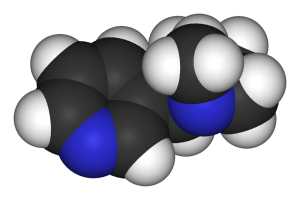
Believe it or not, cigarettes are actually pretty good for you.
So long as you remove the: Ammonia, Cyanide, Ethyl Furoate, Benzene, Arsenic, Maltitol, Polonium, Cadmium, Butane, Carbon Monoxide, Methoprene, Napthalene, Formaldehyde, Lead, DDT, Megastigmatrienone, et cetera, et cetera, you get the point.
Basically, if you toss out everything in the cigarette and leave the nicotine, you may have yourself a bona fide cognitive enhancer with significant clinical potential.
Now put that in your pipe and smoke it!
TL/DNR: Nicotine gets a bad rap for its addictive quality in cigarettes, but as a standalone compound it may deliver quick bursts of cognitive stimulation. With more research nicotine may serve as a viable option for age-related cognitive disorders.
Page Contents
How Nicotine Is Supposed to Work
Nicotine is practically synonymous with tobacco, acting as one of the primary bioactive constituents to the plant. Essentially, nicotine is to tobacco what caffeine is to coffee: It’s an herbal compound generally viewed as a drug for its quick bursts of feel-good mental stimulation.

It’s nicotine that partially makes smoking cigarettes so enjoyable. The psychoactivation induces pleasurable drops in stress & anxiety, relieving tension & worry while acutely improving concentration & reaction time. Yet, it’s also this pleasure response that makes cigarettes addictive: The subsequent release of neurotransmitter dopamine reinforcing reward-seeking behavior related to smoking cigarettes (as well as other “pleasurable” motivational avenues).
Long-term smokers have a hard time quitting due to this reason, which is why many users have to turn to the nicotine patch to avoid withdrawal symptoms upon kicking the habit.
Interestingly, healthy, non-smoking nootropic enthusiasts have turned to the nicotine patch as well, believing the drug to support various cognitive functions when supplemented as a standalone compound. This belief is predicated on the following nicotinic biomechanisms of action:
Activation of Nicotinic Acetylcholine Receptors
The primary bioaction of nicotine is the neuronal activation of nicotinic acetylcholine receptors (nAChRs), protein receptors that respond to both neurotransmitter acetylcholine, which is involved in a few essential nootropic pathways, and nicotine. In response to nAChRs activation, the receptors signal for release of neurotransmitters glutamate, dopamine, norepinephrine, & serotonin. Most notably, nicotine is believed to alter calcium signaling, a basic aspect of cellular life, which may significantly affect brain function.
Potential Antioxidant Activity
This is more speculation than I’m comfortable with, but nicotine is suggested to possess antioxidant protection against free radical damage. However, some research also suggests that nicotine might result in oxidative stress by “inducing the generation of reactive oxygen species in the periphery and central nervous system.” If nicotine does possess significant antioxidant activity, it may explain the compound’s purported status as a neuroprotectant.
Nicotine Benefits
Despite a negative reputation afforded by cigarettes & other illicit tobacco products, nicotine has demonstrated strong therapeutic potential with regards to a number of disease states, most of them cognitive related. For the healthy user, this means improvements on task-related attention & memory, with the upside of nicotine providing long-term neuroprotective support against age-related cognitive dysfunction.
 Is Nicotine Dangerous?
Is Nicotine Dangerous?
Psh, no. Whatever gave you that idea? Ooooh yes: Cigarettes.
Given the harsh long-term effects of cigarettes & other smokable forms of tobacco, nicotine gets a bad rap by association. However, nicotine is falsely accused, as it’s really a mildly active compound on its own, only becoming a problem when mixed with the various toxic cigarette compounds designed specifically to enhance the effects of nicotine. Transdermal nicotine on the other hand is largely recognized as safe & non-addictive, delivering none of the health risks associated with smoking.
Researchers Have Suggested Nicotine Might:
Improve attentiveness in healthy adults (nicotine patch)
7 mg nicotine patches for 4.5 hours daily. This double-blind, placebo-controlled study administered this nicotine regimen to 11 healthy, non-smoker adults, while testing for changes in mood (Profile of Mood States) & attentiveness (Conners’ computerized Continuous Performance Test). Compared to placebo, 7 mg nicotine patches were found to significantly increase self-perceived vigor while decreasing number of errors in the attention tests, leading to the conclusion that “in addition to reducing attentional impairment, nicotine administered via transdermal patches can improve attentiveness in normal adult non-smokers.”
Enhance task-related memory (nicotine spray)
Another double-blind, placebo-controlled study, this time in observance of 1 mg nicotine spray’s effect on prospective memory (ProM), the recall of a planned intention at some future point. A mix of 32 habitual smokers & 33 non-smokers were administered either nicotine spray or placebo, followed by a ProM test. In both smokers & non-smokers, nicotine spray was found to significantly improve ProM measures, supporting the conclusion that “Nicotine improves ProM when the volunteer has no competing task demand.”
Reduce impulsive behavior in ADHD adolescents (nicotine patch)
The aim of this study: Investigate the hypothesis that acute nicotine administration would improve cognitive & behavioral inhibition (i.e. impulsive behavior) in ADHD adolescent non-smokers. To determine nicotine’s effect, 8 teenagers with ADHD received 3 treatments (7 mg nicotine patch, methylphenidate, placebo) in random order on separate days. By the study’s end, the nicotine patch was found to be as effective as methylphenidate at improving inhibition: “nicotine administration has measurable positive effects on cognitive/behavioral inhibition in adolescents with ADHD.”
Ameliorate mild cognitive impairment (nicotine patch)

This 6-month pilot clinical trial investigated the safety & efficacy of transdermal nicotine on cognitive & clinical performance in subjects with mild cognitive impairment (MCI), the transitional cognitive state between full functionality & dementia. For 6 months 74 subjects diagnosed with MCI were administered either 15 mg nicotine patches or placebo daily, while testing for improvements in attention, memory, & psychomotor speed. The results: Nicotine improved all of these measures with an “excellent” safety rating, leading to the conclusion that “transdermal nicotine can be safely administered to nonsmoking subjects with MCI over 6 months with improvement in primary and secondary cognitive measures of attention, memory, and mental processing, but not in ratings of clinician-rated global impression.”
How to Take Nicotine
- Transdermal patches seem to be the best bet for the average nootropic enthusiast, taken in dosages ranging from 7 to 15 mg.
- Nicoderm® offers nicotine patches that range from 7 to 21 mg.
- Nicorette® offers nicotine gum at 2 to 4 mg, in addition to nicotine lozenges, inhalers, and sprays.
My Experience with Nicotine
Aside from the cigarettes smoked behind high school dumpsters and those taken in drunken stupors (“I only smoke when I’m drunk!!”), my nicotine experience is very limited.
 As a nootropic strategy I’ve yet to delve into nicotine.
As a nootropic strategy I’ve yet to delve into nicotine.
And to be honest, up until reading the research required for this review, I’ve avoided nicotinic cognitive enhancers due to the belief that nicotine patches, gum, etc. can be addictive & risky.
In reality, nicotine supplements are relatively safe & side effect-free, with exception to minor side effects such as irritation & itchiness (patch), mouth irritation (gum), nasal irritation (spray), and headache (all). And reportedly these cons are far outweighed by the pros of nicotine, namely in ameliorating cognitive dysfunction.
While I don’t see myself necessarily running to the stores to buy out their nicotine reserves, I may consider nicotine in the future if my primary nootropic stack becomes ineffective for whatever reason at restoring my focus, mood, etc.
Is Nicotine a Good Nootropic?
Given the research, nicotine as a clinical substance seems to be the more interesting topic than nicotine as a nootropic. While I’m not in the business of endorsing treatments (or even discussing substances as treatments), nicotine’s promising results on alleviating mental disorders deserves attention.
It would be a plot twist not even M. Night Shyamalan could predict: Popular cigarette compound has therapeutic properties!
For the average healthy users, nicotine may provide significant support on attention, particularly when cognition is feeling low or diminished. At the least the nicotine rush may supply a feel-good spurt of stimulation, helping you push through that one last thing you needed to do today (assuming you can remember what it was).
Overall Nicotine Nootropic Power Rating
[yasr_multiset setid=0]

